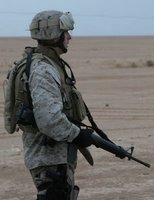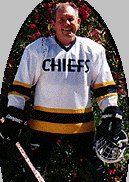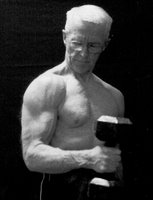Monday, December 26, 2005
Training to Failure
Then I would read how people like Bill Phillips believe in training to failure and wonder how they handle it. I always preferred what Bill Pearl says about the concept. I’m paraphrasing, but Pearl says to end a set when you could do one or two more reps, if you really had to. Finish your workouts leaving a little gas still in the tank.
That makes sense to me.
The other day, I was looking at an article in the latest Men’s Health magazine and the author described two different types of training to failure. One type is training to absolute failure, and the other type is training to technical failure.
He defined training to absolute failure as not being able to complete another rep, no matter what. While training to technical failure is that point when your body posture must change to complete the movement. In other words, when you have to cheat by leaning or swinging forward or back, or you can’t control the speed of the weight you are lifting. That makes a little more sense to me than going to absolute failure.
"Train don't strain" used to be the advice in the old muscle building courses. I think it still makes the most sense of all.
Tuesday, December 20, 2005
From the Gym to Iraq

Not that long ago, Brad Avots was a college student. Patty and I met him at the gym where we workout. For a while, his girlfriend at the time was in the cardio-kickboxing classes we taught.
Brad talked about becoming a Marine. Unlike most college students, segments of his summers were spent in Quantico, Virginia at the U.S. Marine Corps Officer Candidate School.
He also had this very Marine habit of putting on a weighted pack and going up steep slopes (locally, the flanks of Mt. Tamalpais) to stay in shape.
It seems like yesterday, and it really wasn't that long ago, that he graduated from Sonoma State University and the USMC Officer Candidate School. Today, he is 1st Lt. Bradley Avots, and leading a Marine unit in Iraq.
When the Vice President was in Iraq this week, Brad’s Marines were charged with his staff’s security.
Twice, he and his unit have been featured on the late-night TV show, Jimmy Kimmel Live. Patty and I taped it both times and watched the next day.
He gets to come home in February. Let's wish him well.
Monday, December 19, 2005
Winter Cardio

Foul weather finally hit the Bay Area this week.
Patty and I will hike in the rain unless it is truly storming and the trails are mostly sloppy mud holes. Mild rain is kind of fun, and we have a few streams and waterfalls nearby that provide wonderful sights and sounds.
Yesterday was a cardio day and it was pouring. So we decided to go to the gym instead of slopping around in the muck. Patty used an elliptical trainer and I got on a recumbent bike. Not bad. In fact, we rather enjoyed it.
Patty has an iPod and says the music really gets her fired up. I understand. Yet when I’m in the gym pumping iron and look over at the cardio room, it reminds me of a bunch of hamsters on exercise wheels. What are they doing on treadmills when they could be out on a beautiful trail?
It was a good workout. Overall, though, I’ll still take a walk in the woods anytime.
Friday, December 16, 2005
How to Start the Day
We all have our morning rituals. Some begin with coffee, pastry and, God forbid, a cigarette. I guess it kick-starts their engines — while at the same time sending blood sugar/insulin levels through the roof and coating their lungs with gunk. I hope you aren’t one of them.
Patty and I have a cup of coffee, at about 5:30 or 6 a.m., and right afterward we have the almost perfect starter, a breakfast shake made with the following (for two people):
- 3-heaping tablespoons of freshly ground flaxseeds.
- 2-tablespoons of nonfat yogurt containing live friendly bacteria (and no added sweeteners).
- 2-scoops of whey protein powder (40 grams).
- 2-cups of fresh or frozen mixed berries (no added sweeteners).
- 3-cups of plain soy milk (no added sweeteners).
Blend, drink, and take a . . . - Quality multiple vitamin/mineral supplement.
- Glucosamine/Chondroitin/MSN tablet.
- Garlic tablet.
Highly recommended. Maybe you’ll try it. You might also consider pharmaceutical grade fish oil. We don’t take it because we eat quite a bit of salmon, flaxseeds, and walnuts. Ask your doctor.
Tuesday, December 13, 2005
Life Lessons

The first time I saw Art Gearing was about 6-1/2 years ago. I was doing leg presses, looked up, and saw someone entering the gym on skates. I was a new member and Art was a regular. He knew everybody and you could tell everybody liked him. Born in Canada, he is an avid hockey fan and a player. I think it’s genetic.
Art is a couple of years older than I am. He’s had rotator cuff surgery on both shoulders, and his wife, Gerry, passed away last year, after 50 years of marriage. Not an easy time, but Art is tough. And he is close to his two sons, Vince and Dan, and the grandkids.
We used to see each other a lot at the gym. For a long time, he was in our kickboxing class. Now, Patty and I workout earlier the afternoon and we don’t see him as much. Yesterday, though, he came in as we were finishing up. He’s in top shape, still pumping iron, still playing baseball, loving golf, and always has a big smile.
Living life to the fullest usually is a choice people make. Art is a good example of how it should be done.
Monday, December 12, 2005
Fair Weather Sports Fan
Strange, but the Warriors have caught my eye. Patty watches basketball and I’ve never paid much attention to it. Now that the locals are winning, I’ve started watching, too. They’re an okay bunch, young and not yet fully tattooed like NBA versions of the Yakusa.
We go to one Giants baseball game per year. Our friends, Steve and Carolyn, organize a huge annual group tailgate party and we all sit together at the game. Until this past season, Barry Bonds has been kind enough to hit at least one home run at every game we have attended. Yes, it is something to watch him blast that thing out of the park and into San Francisco Bay. Yet, it’s really the tailgate party I enjoy. If we went home right afterward, I wouldn’t miss the game much.
Fair weather fans have the advantage of ignoring bad home teams without guilt. We know what we are. And it leaves more time for hiking in the woods.
Saturday, December 10, 2005
Russian Kettlebells (Part 2): Observation and Opinion
To begin KB training, an average man usually buys one 35-pounder; a woman, an 18-pounder. In class, we were told to buy a weight that we could successfully one-arm military press 3-reps. Generally, you can get a good all around workout with that weight. You can do most lifts with either a single KB or a pair; but you do not have to have a pair of the same weight to workout. If you decide to buy two KBs, you are better off getting two different sizes. As you get stronger and/or more proficient, you probably will want to move up at least one more size.
Hand to hand combat athletes use kettlebells because they believe KB lifting develops functional and explosive strength, as well as endurance. As for me, a senior, I am interested in exploring any method that provides a good workout, variety, and is fun to use. Today, I mix bodyweight calisthenics, free weights, and “machines” for resistance training. A KB could be another viable addition. Do I think a KB might supplant all my other training methods? That's very doubtful.
There also were a couple of technique and training recommendations that I consider unsafe. We were told that there’s really no reason to warm up before training. The instructor said people are “hard wired” to move into action immediately, without warm ups. Well, I understand about adrenalin rush and “flight or fight.” But for day-to-day workouts, starting training sessions with challenging weights and no warm up at all is asking for trouble, in my view.
A questionable lifting concept that seems to be at the heart of low-rep KB lifting requires 1) total body tension; and 2) either holding your breath or expelling it very slowly while under tension. Purposely creating tremendous overall body tension while at the same time holding your breath can be risky stuff — especially for seniors. One of the major U.S. organizations that certifies personal trainers warns, “Holding the breath [while lifting weights] can not only blow out arteries but smaller blood vessels in the eye, even detach the retina. Not a safe practice.”
I think it is better and far safer to follow the commonly advised practice of inhaling on the eccentric part of movements and exhaling on the concentric, without suppressing normal breathing nor holding your breath.
Kettlebells are fun. But I wouldn't take every recommended training concept at face value. Advice that is contrary to practices endorsed by most reliable sources should be seriously considered before tossing out the rule book.
Thursday, December 08, 2005
Russian Kettlebells (Part 1)

Fitness trends come and go. Today, kettlebell training is a hot item. Probably anyone interested in fitness and weight training has heard or read something about kettlebells, those chunks of iron resembling a cannonball with a big handle.
Kettlebells are very “in,” though actually they aren't new. In fact, they are very old. But until recently, they were an almost forgotten part of weight training here in the United States.
Along came Pavel Tsatsouline, a Russian kettlebell lifting champion, and former fitness trainer for the Russian Special Forces. Now an American citizen, Pavel works with the U.S. Marine Corps developing fitness-training programs.
I was curious about Pavel’s training concepts and bought his Power to the People video. In it, he demonstrates and explains his recommended techniques for lifting weights of any sort, not just kettlebells. He has a good sense of humor and stage presence.
By chance, I learned that two of his registered instructors were giving a kettlebell workshop nearby. So I signed up.
We were a class of 12 to 15 people. The ages ranged from a middle school youngster to a geezer (me), with the other ages scattered between the two extremes. We were about evenly divided between men and women.
Our instructors were a friendly and very polished married couple.
They gave a brief overview of kettlebell training concepts, along with cautions about safety (“We have never had anyone injured in a class, and there won’t be anyone injured today.”). Then we were told to select a moderate weight and form three lines.
The first thing we learned was the kettlebell deadlift. No one was to try anything very heavy until mastering the proper back alignment and technique.
Once our instructors were satisfied with our form, we moved on to the kettlebell swing, which seems to be the backbone of kettlebell training. From the deadlift position, gripping a KB with both hands, arms held straight, you swing the weight back between your legs, then up to about chin level and back again. Imagine a giant pendulum swinging from top to bottom, instead of side-to-side. Straightening your legs and snapping your hips forward generates the power.
When we were all showing proper form with the two-arm swing, we graduated to doing it with one arm, then the other.
Next, we practiced the clean, and then the one-arm military press. Great emphasis was placed on achieving total body tension, gripping the handle hard, and either holding your breath or expelling it slowly while pressed the weight.
If you’ve never hoisted a kettlebell, by now you’re probably wondering how it is any different from using a dumbbell. Well, I can tell that it is different.
The unwieldiness of a kettlebell, as opposed to a standard dumbbell, is a big part of what makes KB workouts effective. Controlling them requires all parts of your body acting in unison. Generally, kettlebell people hold so-called isolation exercises in disdain, especially those done with "machines."
The last lift we practiced was the kettlebell snatch, which is mostly the same movement as the Olympic lift of the same name, except of course we were using one arm at a time and a kettlebell. The KB snatch requires the most coordination of the lifts we learned. From the floor, in one quick movement, the weight swings up to just above forehead level, and then is “punched” straight upward above your head.
(Tomorrow: Part 2. Kettlebells: Observation and Opinion)
Wednesday, December 07, 2005
Gluteus Maximus to the Max
At first I thought it was a joke. In hospitals, nurses say that an increasing number of Americans have butts so big and fat that standard needles for giving shots aren’t long enough to give proper dosages of medicine.
The newspaper columnist who wrote about it focused on how “terribly complicated” it is as an issue and how it “crosses a myriad of sociocultural lines.”
Huh?
Well, yes, our nation’s prodigious posteriors got that way because of . . .
- Too much unhealthy food and too much laziness.
- Too much I’m-a-victim thinking.
- A lack of self-control.
- A lack of exercise.
- A lack of decent health education.
- A lousy upbringing.
- Garbage-food corporate marketing.
- Sedentary TV-addicted lifestyles
- Pain-avoidance mechanisms.
- Waiting for the pharmaceutical companies to invent a magic pill.
. . . plus — and here it comes — Americans, the columnist says, eat like hogs because: “We are living in a culture that thrives in war and governmental lies and acidic pseudo-Christian ideologies that most of us know, on a deeper, karmic level , are pure poison.”
I just knew it! It is the war that is making me fat, along with those "acidic pseudo-Christian ideologies." How can I be expected to control myself?
Well, try this:
"If you are fat, and you don’t want to be fat, the first thing you have to do is decide that you are not going to be fat anymore. That's the key to your success in this game." –Matt Furey
Ah, but that’s far too simplistic to solve such a complex issue.
Monday, December 05, 2005
Intuitive Eating
I’m not sold on calorie counting, either. I think there are more convenient and practical ways for portion control eating. But would you tell an alcoholic to stop thinking about staying sober and instead pay attention to cravings for booze? You can read the whole story at http://news.yahoo.com/ --Gray Iron
Sunday, December 04, 2005
 Beginning
BeginningI have been writing the Gray Iron Fitness Newsletter for several years now. This is my first entry in the new Blog.
If this were a big company, I would have subscriber demographics at hand to guide me in deciding what is important to you. The Gray Iron Fitness office consists of me at my computer, along with some help from Patty (a.k.a. Mrs. Gray Iron), who also keeps herself busy as a classroom teacher in a middle school. Those aren’t complaints, mind you. At our stage in life (seniors), we kind of like things the way they are.
Demographics or not, I do have some reasonable assumptions about you. The number one assumption, or course, is that you take seriously your strength, physical fitness and health. Most of you are at mid-life or more.
Without much more to go on than that, I simply convey what I have learned about staying strong, fit and healthy while growing older. I draw on personal experience as well as sources that I consider legitimate and reliable. I try to filter out the nonsense and hyperbole that surround the subject.
The web site (http://www.grayironfitness.com/) and the Gray Iron Fitness Newsletter have been successful. Let's see how it goes with the blog. Your questions, suggestions and comments will be appreciated.
